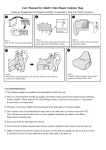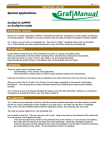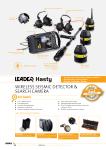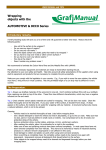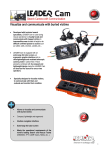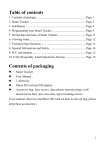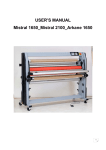Download Grafiprint laminates LAMGLOW - grafityp selfadhesive products
Transcript
User Manual LAMGLOW Page. 1 of 2. USER MANUAL and TIPS Special applications. Grafiprint LAMGLOW on Grafiprint media Introductory remarks. LAMGLOW can be used for much more than just the well-known applications. The special characteristics of this laminate offer the designer the possibility to give full vent to his creativity by working out extremely original ideas. When parked in a dark parking lot, your car will keep showing showing its striking publicity for many hours, and you will easily find it. The cast film can be processed with ease, but because of its thickness, it is less suited for wrapping. The whiter the surface, the better the phosphorescent result. Tip 1: Make sure your prints are completely dry. They have to “degas” completely before they are laminated. Tip 2: Check whether you have enough laminate left on your roll before starting the laminating job. The Preparation. It goes without saying that you need to laminate your prints in a propre and dustfree space. Never put printed rolls on the floor before laminating them, otherwise they would attract dust particles. Also make sure there is no dust or dirt on your clothes, e.g. from sawing the panels. Avoid touching the printed surface or the adhesive layer of the laminate with your fingers. Laminating. There are various ways to laminate a print : - Cold laminating: can be used for most applications. - Warm laminating: is always better to achieve a good adhesion between print and laminate. Follow the instructions in the manual and pay attention to the safety instructions that come with your laminator. Allow your print to dry for at least 24 to 48 hours (or even longer, depending on the amount of ink) before laminating it. This will guarantee an optimal adhesion between the Grafiprint print media and the Grafiprint laminate. Tip 3: Remove all excess of laminate alongside the edges of the print after laminating. Nothing is as annoying as small pieces of laminate that stick to your print while unrolling it. The Application. Tip 4: Make sure the workshop is dust-free, that the necessary ambient temperature has been reached, and that the job can not be complicated by direct sunlight or by a heat source. Also make sure the floor is completely clean, as the vinyl gets statically loaded during the application process, thus attracting dust very easily. The vinyls are always applied dry or wet (preferably dry). Run a couple of tests first. They can save you a lot of work. Apply a test strip on the paintwork of the vehicle and on a side window, and compare the result. - If the test strip sticks much harder on the paintwork than on the window, or if you see lots of air bubbles, this means that the vehicle has not been pre-treated sufficiently. Repeat the isopropanol treatment. - If the test strip does not stick sufficiently, this means that probably a very thin layer of (silicone) protection has stayed behind on the vehicle. The pre-treatement needs to be repeated. User Manual LAMGLOW Page. 2 of 2. The tools: - Felt squeegee - Cutting knife - Heat gun - Extension cord - Sufficient light - Roll of tape - Electric current - Meter, felt-tip, pencil, … The preparation: - Place the vinyl (with its backing paper) on the surface. - Always avoid cutting in the surface. - Apply some reference points where vinyle and surface meet, so you easily place the vinyl at its exact position again. The application of the vinyl: - Remove the backing paper from the vinyl. - Position the vinyl without folds against the reference points you applied earlier. - Rub the vinyl smoothly by means of the felt squeegee. Make sure that the air between the object and the vinyl can always escape. Tip 5: Never lay a felt squeegee on the floor. Sand will creep into the squeegee, and you will make scratches on the vinyl the next time you use it. The Finishing. Small air bubbles will disappear automatically after a certain period of time. Larger air bubbles on even surfaces need to be punctured to allow the air to escape. After the job has been completed. - Make sure your work is not immediately exposed to the cold or to humidity. Allow the adhesive enough time to adhere to its new surface. The optimal adhesive strength is reached after about three days. Cleaning and Maintenance. - We advise you not to clean the vehicle with a high-pressure cleaner. Vinyl is a soft material. Therefore the cleaning and maintenance shall only be executed with non-scouring cleaning agents, without strong solvents or corrosive ingredients. If you want to give the vehicle some additional gloss after a certain period of time, you can “polish” it. Please only use the products that are specifically meant for this application. The old application “wax on – wax off” with a polishing paste is not applicable in this case. Removal of the vinyl. Grafiprint materials have been developed especially not to leave behind any glue residues after removing them. If you wish to remove the vinyl, we advise you to heat it with a heat gun. Pull off the vinyl under an angle of 90°. If any glue stays behind on the surface, you can remove it with isopropanol. Tip 6: If any glue residues stay behind, this is often because the vinyl is too warm and the adhesive is too cold. Just wait for a moment until the heat has reached the area between the adhesive layer and the paintwork, and things will become much easier. You will find the right balance between heating and removing the vinyl after some practice. This GrafiManual is not to be considered as a complete product manual. It is only meant as a tool, to give you an idea of the possibilities and the application of the above-mentioned products. More detailed information about these products can be found in the product data sheets and on www.grafityp.com.


